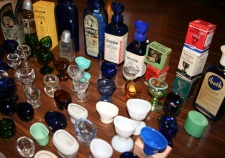It began by accident. “I was just doing a favor for my brother,” explains Terry Jermac of Peoria. “He found an eyewash cup in the cupboard at my grandmother’s house… and told me he had started collecting these things. I said, ‘What the hell is an eyewash cup?’
“I was always going to flea markets and garage sales, and once I found out what they looked like, I started noticing them… So I’d buy a few here and there, and before I knew it, I had 30 or 40. It turned out he had everything [I had], so I was stuck with them. Then I started taking an interest in it.”
For several hundred years—until modern eye drops were developed—eyewash cups, or eyebaths, were the most common way to relieve the eye of irritants. People would fill them with water, hold them to the eye, throw their heads back, and blink to flush away unwanted elements. Developed in England in the 16th century, they are rarely used today, though there remains a steady mass of collectors.
Vintage eyewash cups come in a variety of shapes, sizes and colors, and are made from materials ranging from tin, wood and plastic to porcelain, glass and rubber—even silver and gold. Some were mounted on pedestals; others, called “squats,” came attached to bottles of solution. They can be smooth and rounded, or have panels on the sides, shaped like tulips or patterned like barrels. They are most often clear, blue or green, while ambers are prized for their relative scarcity. Some were even hand-blown—these are typically the most expensive.
 The center of the collecting world remains London, where they were first invented. In the ‘90s, Jermac and his brother went overseas three times in search of missing items for their collections. “We went to London, Scotland and Wales, then over to Ireland,” he says. “In London, there are a lot of antique shops and dealers, and my brother was able to make contact with some collectors. That was the hotspot if you wanted anything out of the ordinary. We went to the museum in London, saw some great collections, and took pictures and videos of ones that were just out of this world.”
The center of the collecting world remains London, where they were first invented. In the ‘90s, Jermac and his brother went overseas three times in search of missing items for their collections. “We went to London, Scotland and Wales, then over to Ireland,” he says. “In London, there are a lot of antique shops and dealers, and my brother was able to make contact with some collectors. That was the hotspot if you wanted anything out of the ordinary. We went to the museum in London, saw some great collections, and took pictures and videos of ones that were just out of this world.”
The Internet, of course, has changed everything. “Before, you sent pictures, wrote letters and talked on the phone [to other collectors],” says Jermac. “Now, they just put them on eBay. So it kind of took away the secrecy of it, but it also took away the hunt.” A quick eBay search reveals a variety of eyewash cups, most in the $15-20 range. The most expensive? A vintage, rubber eyewash cup from the late 19th-century, priced at $160.
Today, Jermac has about 350 of them, though he’s no longer a very active collector. Among his favorites are the porcelain cups and the hand-blown ones—“because there’s an art involved. It wasn’t mass-produced.” a&s


